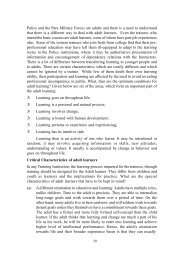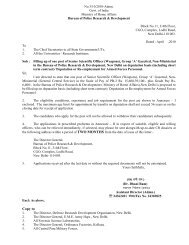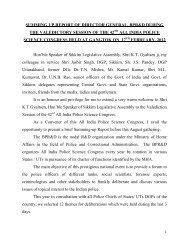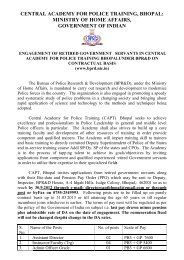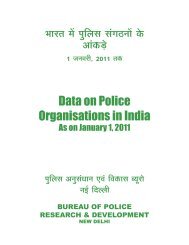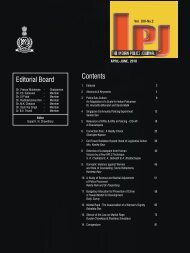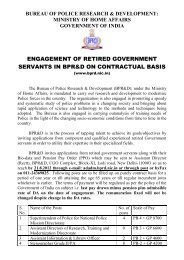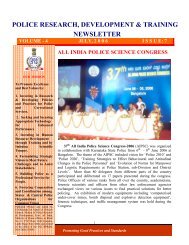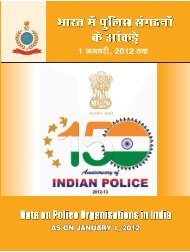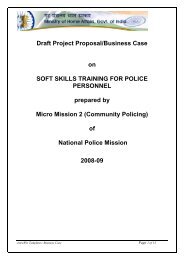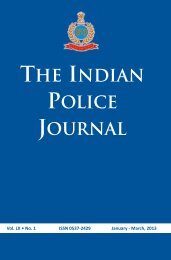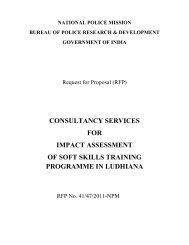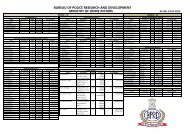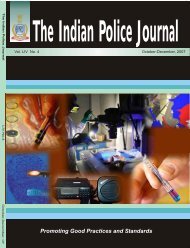The most memorable part <strong>of</strong> my stint in the IBwas the four year period (1965-68) I spent inNagal<strong>and</strong>. It was a very exciting period. Every daythere was a new challenge, a new development,a new threat or an otherwise disturbing piece<strong>of</strong> information. I had all the time, a feeling<strong>of</strong> contributing to the country’s fight againstinsurgency in a very sensitive area. This was astrong motivation <strong>and</strong> brought the best out <strong>of</strong> me.There were far too many challenging incidents. Iwould reminisce just two <strong>of</strong> them– one when Iwalked incognito into a Naga Army Camp <strong>and</strong>spent the night there, <strong>and</strong> the other when Nagarebels, on learning that I was the brain behindthe raid on their Jotsoma camp, issued an ahza(order) for my annihilation.Visit to LephoriThe Naga underground had a well organisedparallel government – it was called ‘Naga FederalGovernment’ with a President, Prime Minister(Ato-Kilonser) <strong>and</strong> Ministers (Kilonsers). The armedwing, known as ‘Naga Army’, had a Comm<strong>and</strong>erin-Chief<strong>and</strong> it was divided into battalions. Thetenth battalion had its headquarters at Lephoriin the Pochury area, quite close to the Myanmarborder. During one <strong>of</strong> my tours, I went to Meluri,which was our outpost in the Pochury area. TheAssistant Central Intelligence Officer incharge <strong>of</strong>the outpost was one Ch<strong>and</strong>rika Singh, a daring<strong>of</strong>ficer who was a storehouse <strong>of</strong> information onthe Nagas. He suggested that we undertake a trekto Lephori, with a view to getting an idea aboutthe strength <strong>of</strong> the Naga Army camp there, theweapons stored <strong>and</strong> their defences. Ch<strong>and</strong>rikaSingh was known in the area as he met theunderground leaders quite frequently. My goingas Assistant Director <strong>of</strong> the Subsidiary Intelligence<strong>Bureau</strong> (SIB) was a different proposition. It wasbound to be viewed with suspicion. However, Idecided that we should go. For reasons <strong>of</strong> safety,a story was cooked up to camouflage my identity.I was to be introduced as an Assistant Pr<strong>of</strong>essor<strong>of</strong> History from Allahabad (which, in any case, Ihad been), who had come to collect material onthe history <strong>of</strong> the Nagas.Meluri to Lephori was a ten mile stretch. It wasnot much <strong>of</strong> a distance. But half the distance was adescent <strong>and</strong> the remaining half was a steady uphillclimb. It was a difficult trek. We reached Lephorilate in the afternoon. The Naga Army personnelwere playing volleyball at the time. As they sawus approaching, they stopped the game <strong>and</strong> weresurprised that we should have ventured into theircamp. We were, <strong>of</strong> course, unarmed. Self-styledLt. Col. Henito Sema, who was Comm<strong>and</strong>ant <strong>of</strong>the tenth battalion, accosted us. He in fact gaveus a hostile reception. He shouted at Ch<strong>and</strong>rikaSingh for having come to the camp without anyprior notice or permission. Ch<strong>and</strong>rika Singhused all his tact <strong>and</strong> persuasive skill to convinceHenito that we had no evil designs <strong>and</strong> that it waspurely a friendly visit. Arguments <strong>and</strong> counterargumentswent on for about ten minutes beforeHenito could be pacified. I was a silent spectatorto their exchanges. Henito finally relented <strong>and</strong>asked his men to usher us into a basha (hut),where we could stay for the night. I must say theNaga Army personnel treated us very well. Wewere <strong>of</strong>fered madhu (rice beer) by a young girl ina chunga (mug). I did not like the taste <strong>of</strong> it, but ithad to be consumed. Sleeping in the Naga Armycamp was an unforgettable experience.Next morning, to keep up the facade <strong>of</strong> research,I collected some village elders <strong>of</strong> Lephori <strong>and</strong>pretended to elicit information out <strong>of</strong> them aboutthe origin <strong>of</strong> the Nagas. They could tell me onlyabout a folk tale on the subject. At the beginning<strong>of</strong> creation, according to the story, God gave theknowledge <strong>of</strong> reading <strong>and</strong> writing both to thehillman as well as the plainsman. The plainsmanwas given paper to write upon while the hillmanwas given skin. As it happened, the hillm<strong>and</strong>evoured the skin when he found it edible. TheNagas have consequently no record <strong>of</strong> their past.I told them that the Nagas were none else thanthe Kiratas, frequently mentioned in old Sanskritliterature. The Mahabharata mentioned the King<strong>of</strong> Kamrup fighting on the side <strong>of</strong> Kauravas alongwith the Kirata warriors. The Ramayana alsomentioned the Kiratas. The village elders listenedto me with interest, but they appeared confused.Thereafter, we bade good-bye to Henito <strong>and</strong> theNaga boys <strong>of</strong> the camp <strong>and</strong> left for Meluri. Wewere both thrilled with the experience. We werealso relieved that everything had gone accordingto plan.A few months later, we came across an intercepteddocument from self-styled Lt. Col. Henito Semato another person which contained a reference toour visit to the Naga Army camp at Lephori. Henito74The Indian <strong>Police</strong> Journal, October - December, 2012, Special Issue
stated that Prakash Singh, Assistant Director,Intelligence had visited their location undercover, that he should not have done that, <strong>and</strong> thatif the Naga Army personnel had discovered hisreal identity, the consequences would have beendisastrous. In retrospect, I should thank God thatI could come out <strong>of</strong> the Naga Army camp withmy head still in place (Nagas were earlier a tribe<strong>of</strong> head-hunters)!Jotsoma RaidThe other unforgettable incident relates to theSecurity Forces’ raid on the Jotsoma camp <strong>of</strong> theNaga underground in 1968. The Government’spolicy hitherto had been to intercept the incomingor outgoing gangs outside the area covered bythe suspension <strong>of</strong> operations agreement, thatis in the three mile belt along the internationalborder where the Security Forces’ right to patrolwas recognised. The underground, on the otherh<strong>and</strong>, moved about with arms <strong>and</strong> in uniformwith impunity, collected taxes, recruited men,<strong>and</strong> imported arms from abroad brazenly. It wasobvious that they were abusing the agreementto regroup their ranks <strong>and</strong> build up their fightingpotential. A more positive approach was calledfor on the part <strong>of</strong> the Government. It was usheredin by B.K.Nehru, the new Governor <strong>of</strong> Nagal<strong>and</strong>,who openly declared that the Government shalltake necessary action to see that “breaches <strong>of</strong>cease-fire by the underground are nullified”.The GOC 8 Mountain Division, Maj. Gen. N.C.Rawlley, was also a man <strong>of</strong> tremendous drive<strong>and</strong> initiative. This combination <strong>of</strong> Nehru <strong>and</strong>Rawlley brought about a complete transformationin the situation in Nagal<strong>and</strong>. The undergroundswere forced to give up their aggressive posture<strong>and</strong> the fangs <strong>and</strong> claws <strong>of</strong> the ‘Naga FederalGovernment’ were for once broken.China had around this time started meddling inthe north-east; the objective being to weakenIndia’s flanks. The first Naga Army gang to China,about three hundred strong, had crossed theTuensang border in November 1966 <strong>and</strong> wentover to China for training <strong>and</strong> weapons. It wasled by Thinuselie <strong>and</strong> Muivah. The gang returnedin January 1968 <strong>and</strong> dispersed in the Angami,Chakhesang <strong>and</strong> Ao areas. About two hundred<strong>and</strong> fifty <strong>of</strong> them set up a camp in a deep junglenear Jotsoma in the Angami area. Here they werejoined by some other Naga Army personnel also.The total strength, in due course, swelled to aboutfour hundred <strong>and</strong> fifty.The Government had intelligence about the reentry<strong>of</strong> the Naga Army gang from China, but itwas in the dark about their exact location. TheGOC was particularly anxious <strong>and</strong> he asked meto develop information about the exact location<strong>of</strong> the China-returned gang. It took me about amonth to get pinpoint information. The gang waslocated near village Jotsoma in the Angami area <strong>of</strong>Kohima district. A plan <strong>of</strong> action was thereuponworked in consultation with the GOC 8 MountainDivision. We gave two sources who would leadthe Security Forces’ columns to the camp. TheArmy mobilised about one Brigade strength <strong>of</strong>troops to surround <strong>and</strong> attack the camp.The operation was launched in the early hours<strong>of</strong> June 7, 1968. The Security Forces marchedthrough an unfrequented route <strong>and</strong> weresuccessful in laying siege to the camp. This wasby itself no mean an achievement, in an areawhere intelligence about the movements <strong>of</strong>Security Forces, more <strong>of</strong>ten than not, reached theunderground in advance. However, while thecordon was being laid, one <strong>of</strong> the hostiles goingfrom the camp to perhaps another village noticedthe movement <strong>of</strong> troops, <strong>and</strong> he rushed back toalert the Naga Army personnel. In the next twohours, before the engagement actually began, theunderground hurriedly packed their weapons,<strong>and</strong> the hard core, including Thinuselie managedto sneak out. One company <strong>of</strong> the Security Forcesled by Major Biswas walked into an ambush <strong>and</strong>they were sprayed with bullets. Several <strong>of</strong> them,including Major Biswas, fell. A fierce encounterfollowed on the precipitous heights. Sporadicfighting continued on June 8 <strong>and</strong> 9 also. TheSecurity Forces captured twenty-five Naga Armypersonnel, together with a large quantity <strong>of</strong>Chinese arms <strong>and</strong> ammunition. The equipmentseized included 60 mm mortars, 7.62 mm selfloadingrifles with folding bayonets, sten-guns<strong>and</strong> .303 rifles. Besides, a substantial volume <strong>of</strong>documents, papers <strong>and</strong> diaries, giving conclusiveevidence <strong>of</strong> the underground’s collusion withChina were recovered.The Jotsoma encounter was militarily not much<strong>of</strong> a success. The Indian Army suffered casualties,<strong>and</strong> though the exact number was never givenThe Indian <strong>Police</strong> Journal, October - December, 2012, Special Issue 75
- Page 1 and 2:
The Indian Police JournalOctober -
- Page 3 and 4:
From the Director’s DeskNew Delhi
- Page 5 and 6:
23rd December, 1887: TheJourney beg
- Page 7 and 8:
Courtesy - National Archives of Ind
- Page 9 and 10:
The Logo released on the completion
- Page 11 and 12:
Helmsmen of the IB during thePre-In
- Page 13 and 14:
SHRI V.G. VAIDYA, IPS(MAR 1992 TO J
- Page 15 and 16:
“Sleeman sahib ki jai”“No Cri
- Page 17 and 18:
their life and their problems relat
- Page 19 and 20:
Settling down of criminal tribes wa
- Page 21 and 22:
perish. Between 1841 and 1848, anot
- Page 23 and 24:
In conclusion, I would like to reco
- Page 25 and 26:
own race alone, had to be withdrawn
- Page 27 and 28:
a bee in his bonnet” 17 , and abo
- Page 29 and 30:
epresented by Tilak and his followe
- Page 31 and 32:
The agency more and more fine-tuned
- Page 33 and 34:
US was brewing, one William Hopkins
- Page 35 and 36:
came under the control of Indian mi
- Page 37 and 38: neutralised many efforts by inimica
- Page 39 and 40: e published by the Intelligence Bur
- Page 41 and 42: As DD (Security), IB, I had occasio
- Page 43 and 44: Chhomohlohri, all of them juxtapose
- Page 45 and 46: Dormers Building, ShimlaThe Dormers
- Page 47 and 48: eforms. Warren Commission, on the a
- Page 49 and 50: and systems will increasingly come
- Page 51 and 52: violence and destabilisation. This
- Page 53 and 54: one develop. The all pervasive cult
- Page 55 and 56: etween the states and the centre su
- Page 57 and 58: Intelligence Agencies inIndian Demo
- Page 59 and 60: Democracies are, today, everywhere
- Page 61 and 62: depend substantially on the restrai
- Page 63 and 64: Of Pistols and Pigs andthe Old Tidd
- Page 65 and 66: it is lovingly caressed hundreds of
- Page 67 and 68: Through the Eyes of an IB OfficerSh
- Page 69 and 70: an Intelligence agency. He used to
- Page 71 and 72: My J&K ExperienceShri R.K. Kapoor,
- Page 73 and 74: there. We remained stranded there f
- Page 75 and 76: Scaling Himalayan Heights withthe I
- Page 77 and 78: proceed to Dungti to supervise the
- Page 79 and 80: tour of the White House and Lincoln
- Page 81 and 82: into unconsciousness two hours earl
- Page 83 and 84: which was completed successfully wi
- Page 85 and 86: leaders. This happened around the t
- Page 87: My Unforgettable Yearsin the North-
- Page 91 and 92: take her into confidence. That woul
- Page 93 and 94: Police - Intelligence InterfaceShri
- Page 95 and 96: Shreekant Bapat and I surveyed the
- Page 97 and 98: excellence, dedication and commitme
- Page 99 and 100: Immigration, Inter-State Disputes,
- Page 101 and 102: Observations on India’s State and
- Page 103 and 104: assessments that arose after the ca
- Page 105 and 106: levels. The deficiencies of one par
- Page 107 and 108: of laying a network of useful roads
- Page 109 and 110: Technology in Intelligence-Future S
- Page 111 and 112: These are just some of the aspects
- Page 113 and 114: Figure 6: Open Source Information o
- Page 115 and 116: events) and inference from evidence
- Page 117 and 118: 9North Atlantic Treaty Organization
- Page 119 and 120: Shri Dave was posted back to the lB
- Page 121 and 122: He even suggested separate pay scal
- Page 123 and 124: The Unsung HeroesThe Intelligence B



